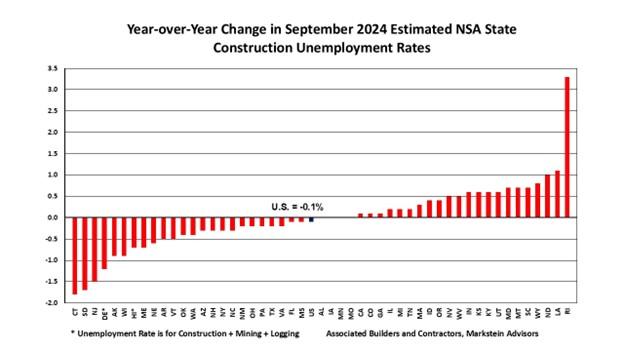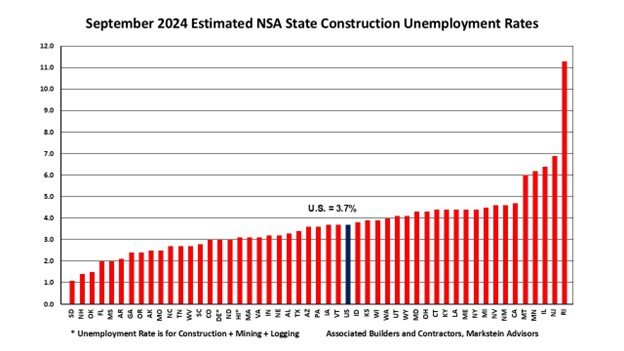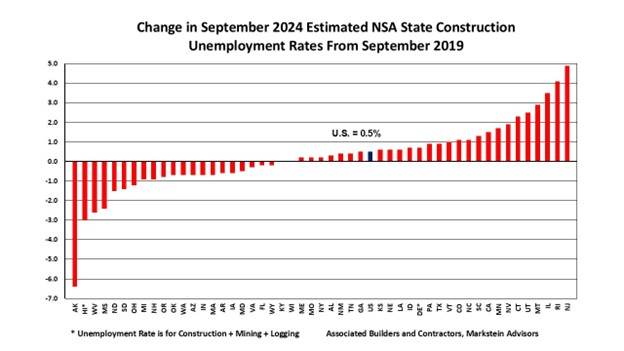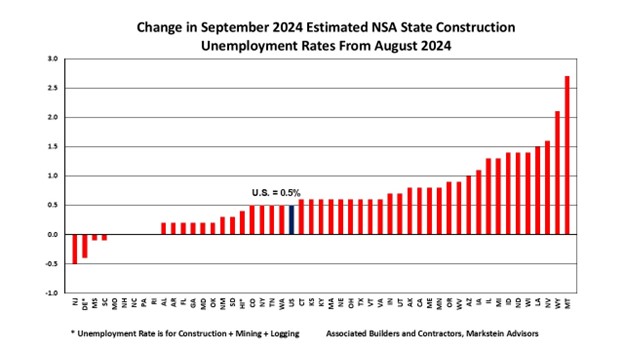ABC: Almost Half of State Construction Unemployment Rates Down From a Year Ago
WASHINGTON, Nov. 4—The national September 2024 not seasonally adjusted construction unemployment rate was 3.7%, down 0.1% from the previous year, according to Associated Builders and Contractors’ state-by-state analysis of U.S. Bureau of Labor Statistics data. The analysis also found that 24 states had lower construction unemployment rates over the same period, four states were unchanged and 22 states were higher.

National NSA payroll construction employment was 230,000 higher than last September. Since February 2022, seasonally adjusted construction employment has exceeded its pre-pandemic peak of 7.6 million. As of September 2024, SA payroll construction employment stood at 8.3 million.

There is some indication of loosening of the construction employment market relative to its pre-pandemic level. As of this September, 21 states had lower construction unemployment rates compared to September 2019, 27 states had higher rates and two states (Kentucky and Wisconsin) were unchanged.

“Construction employment continues to grow, reflecting the overall strength in the economy,” said Bernard Markstein, president and chief economist of Markstein Advisors, who conducted the analysis for ABC. “Construction activity and employment will be aided by lower interest rates as the Federal Reserve eases its monetary stance. Continued federal infrastructure spending will be an added source for construction employment.”
Recent Month-to-Month Fluctuations
In September, nationally, the estimated construction unemployment rate increased 0.5% from August. Only four states had lower estimated construction unemployment rates than in August. Meanwhile, 41 states had higher rates and five posted the same rate. High temperatures throughout the country, particularly in the West, along with significant rain in the Southeast, contributed to the higher construction unemployment rates in much of the country.

The Top Five States
The five states with the lowest estimated NSA construction unemployment rates for September were:
- South Dakota, 1.1%
- New Hampshire, 1.4%
- Oklahoma, 1.5%
- Florida and Mississippi (tie), 2.0%
All five states posted their lowest September NSA estimated construction unemployment rate on record. Also, among the states, South Dakota had the second largest year-over-year decline in its rate (down 1.7%) behind Connecticut (down 1.8%).
The Bottom Five States
The five states with the highest September estimated NSA construction unemployment rates were:
- Montana, 6.0%
- Minnesota, 6.2%
- Illinois, 6.4%
- New Jersey, 6.9%
- Rhode Island, 11.3%
New Jersey had the largest monthly decrease in its NSA estimated construction unemployment rate (down 0.5%) and the third largest year-over-year decline (down 1.5%) among the states.
Click here to view graphs of U.S. and state overall unemployment rates (Tab 1) and construction unemployment rates (Tab 2) showing the impact of the pandemic, including a graphing tool that creates a chart for multiple states. To better understand the basis for calculating unemployment rates and what they measure, check out the Background on State Construction Unemployment Rates.